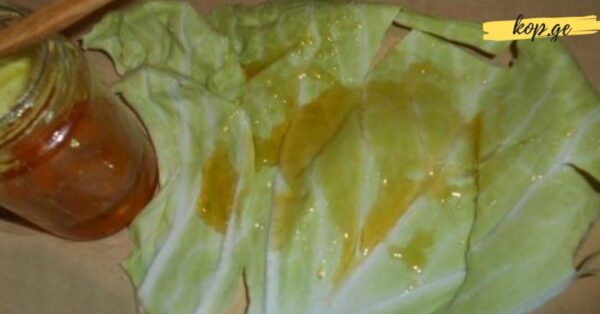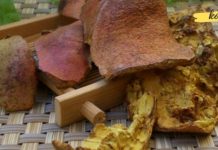How to Get Rid of a Cough with a Cabbage Leaf? This Simple Procedure Will Completely Relieve Your Cough

It is quite rare to find someone who has never experienced a cough, one of the most common symptoms of respiratory illnesses. While a cough is often viewed as a mere annoyance, it serves an important function: it signals irritation or inflammation somewhere within the respiratory system. This might not always mean that there is an infection in the bronchi, trachea, or lungs. Sometimes, coughing can be caused by bronchospasm, inflammation of the larynx, heart failure, or other health conditions. In this article, we explore how you can treat a cold-related cough naturally and effectively using a simple, traditional remedy with cabbage leaves.
A cough is a reflex, a symptom indicating irritation or inflammation of the mucous membranes lining the respiratory tract. When you have a cold, treatment is usually not aimed at suppressing the cough but rather at helping to expel mucus and clear the airways. It is important to begin treatment as early as possible at the first signs of a cold to prevent further complications such as pneumonia or bronchitis.
The Traditional Remedy: Cabbage Leaf and Honey for Cough Relief
The use of cabbage leaves combined with honey to treat coughs is an ancient remedy passed down through generations. Our ancestors discovered this natural method due to the unique healing properties of cabbage. Besides being rich in minerals and vitamins, cabbage contains essential oils, antioxidants, organic acids, and many other substances beneficial to the body. Honey, well-known for its soothing and antimicrobial properties, complements the effect. However, honey should be used carefully because it can sometimes cause severe allergic reactions.
Before starting treatment with cabbage leaves and honey, it is advisable to perform a simple allergy test to honey to ensure safety. To do this, apply a small amount of honey on a piece of cabbage leaf, then place it on the inside of your elbow. If after 10 minutes there is no redness, itching, or irritation, it is safe to proceed with the treatment.
How Does the Cabbage Leaf Compress Work?
The cabbage leaf is most commonly used as a compress to relieve cough symptoms. The compress helps fight infection, reduce pain, and ease inflammation. It also warms the chest, which can soothe persistent coughing. Often, just a few treatments are enough to experience significant relief.
Step-by-Step Guide to Making a Cabbage Leaf Compress
Take fresh, slightly wilted cabbage leaves. Remove the central, tougher ribs to make the leaves more pliable.
Briefly immerse the leaves in boiling water for about one minute. This softens the leaves and makes them more flexible.
After heating, gently crush the leaves with a rolling pin or by hand until they start to release their natural juices.
Warm a small amount of honey by placing it in a bowl over hot water (a water bath).
Spread about one tablespoon of honey evenly over the surface of a cabbage leaf.
Apply the honey-coated leaf directly onto the chest area.
Cover the compress with a warm cloth or cotton fabric to hold it in place.
Wrap the chest with a warm scarf or towel to keep the compress warm and secure.
Using the Compress Effectively
If the cough is in its early stages, one cabbage leaf compress on the chest may be sufficient. However, if the cough has worsened or if symptoms persist, apply one cabbage leaf compress to the chest and one to the back each night. Continue this treatment for 3 to 5 consecutive nights.
Generally, after this period, the cough should significantly improve or disappear entirely—provided the treatment was started in a timely manner.
Aftercare and Additional Advice
In the morning, remove the compress and gently clean the skin with a damp towel. Dress warmly afterward to maintain body heat and continue the healing process.
If the cough is accompanied by headaches or fever, this may indicate a bacterial infection or another underlying condition that requires medical attention. In such cases, it is important to consult a healthcare professional promptly.
Why This Remedy Works
Cabbage leaves contain compounds with anti-inflammatory and antibacterial properties. The warmth and moisture of the compress help to soothe irritated tissues in the respiratory tract, reducing the urge to cough. Honey adds to this effect by coating the throat and reducing inflammation. Together, they form a natural, non-invasive treatment that helps the body fight off the irritation causing the cough.
Other Benefits of Cabbage for Health
Beyond its use for coughs, cabbage is rich in vitamin C, vitamin K, and several antioxidants. It supports the immune system and helps the body fight infections. Applying cabbage leaf compresses has also been traditionally used to relieve joint pain and inflammation due to its cooling and healing properties.
Precautions and Who Should Avoid This Treatment
While this remedy is generally safe, it is not recommended for children under one year old due to the risk of honey-induced botulism. People with severe allergies to honey or cabbage should avoid this treatment. Always perform the allergy test beforehand.
Additionally, if symptoms persist beyond a week or worsen, seek medical advice to rule out serious conditions such as pneumonia or chronic bronchitis.
Final Thoughts
Natural remedies like the cabbage leaf compress have stood the test of time for good reason. They offer safe, effective relief from common ailments such as coughs without the side effects often associated with pharmaceutical drugs. By embracing these simple traditions, you can support your body’s healing process naturally.
Remember to start treatment early when cold symptoms first appear to prevent complications. And always be mindful of your body’s reactions and consult a doctor if needed.












